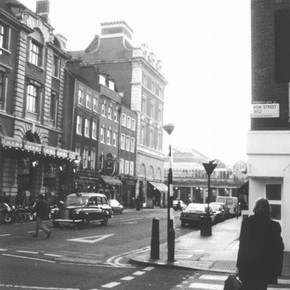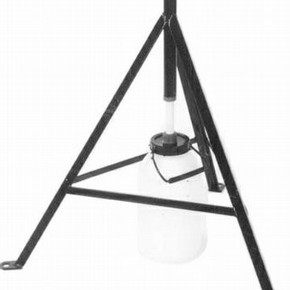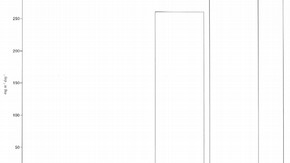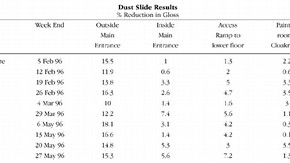Conservation Journal
January 1997 Issue 22
Slides and Frisbees - Determining Dust Deposition Rates

Figure 1. Buildings opposite the Theatre Museum. Photography by David Ford (click image for larger version)
Earlier this year the Royal Opera House received funding to redevelop their site on the north side of Russell Street, London, WC2. This project involved the demolition of buildings immediately opposite the V&A's Theatre Museum at Covent Garden (Figure 1). Concerns were raised that this building work could pose a risk to the collection at the Theatre Museum by creating high levels of dust in the immediate area. It was decided that it was necessary to start a monitoring programme to measure dust levels before and during the main demolition work. Primarily, the aim of this project was to determine whether dust levels had increased within the Theatre Museum due to the redevelopment nearby. This article outlines the reasons for selecting the methods, the basic principles behind the chosen methods and a summary of the initial findings.
Many techniques are available for the assessment of dust in air, these include:
-
High volume air sampling that uses a pump to draw a sample of air through a preweighed filter;
- Light scattering techniques that measure changes in radiation when a beam is interrupted by dust particles;
- Passive samplers that measure dust that falls onto a surface by techniques described later.
The majority of these techniques find use in the occupational hygiene and pollution measurement fields. Two passive techniques were found to be of particular interest and these are described below.
The challenge in this instance, was to find techniques that could be interpreted with direct relevance to the collections i.e. object centred. The technique chosen should give a clear indication of the dust levels that may be accumulating on the object. Techniques were sought that had minimum aural and visual impact, low power requirements and data easily comparable to the objects. Budgetary restraints were significant in selecting the appropriate monitoring method.
Passive methods were initially chosen because they are readily comparable to Museum objects. Two types of passive systems were chosen, a Dry Frisbee Dust Deposit Gauge (DFDG) and a Glass Slide Deposit Gauge (GSDG), each having particular advantages. Obviously, differences in electrostatic properties, surface morphology and micrometeorology between the samplers and the objects did not allow direct comparisons. Monitoring passively had the advantage that it met the criteria for reduced maintenance and cost requirements while minimising noise and power problems. One draw back to the techniques chosen was their comparatively long sampling times.
Glass Slide Deposit Gauge
Glass Slide Deposit Gauges (GSDG) compare the 'gloss' on a glass microscope slide before and after exposure. 'Gloss' or surface reflectance is measured using a calibrated gloss meter1. Slides are normally in location for seven days before readings are taken; this is the time it usually takes for a representative sample to be formed, after this period scouring or stacking may affect the results. Moorcroft and Laxen found that a soiling rate of 10% reduction in gloss over one week was acceptable to a number of observers2. However, this figure does not relate to museum objects and may be higher than the levels acceptable to the museum professional and general public. A figure of 5% has been suggested for museums3 . Scanning Electron Microscopy (SEM) can be used to identify the constituents of the dust deposited on the slide. Since the V&A does not have the necessary equipment or expertise, this work was carried out by Queen Mary and Westfield College.
Dry Frisbee Deposit Gauge
Standard methods for the measurement of dry deposition are set out in British Standard 17474. The work at the Theatre Museum used a cheaper and more efficient adaptation of this standard5 . A Frisbee shaped dish, placed on a stand 1.7m above the ground, was to act as a collection surface (Figure 2). In the field, the DFDG would rely on rain to wash the particulate matter into a collection bottle. Since rain was unlikely in the Theatre Museum, deionised water was sprayed gently over the gauge every few days using a plant watering bottle. After one month the water in the bottle was filtered through a pre-weighed equilibrated filter paper; the paper was then re-equilibrated and weighed to measure the quantity of dust deposited. A simple equation gives the rate of deposition per square metre per day.
Results
In a survey of this nature and duration the data sets are limited. This prevents the use of normal statistical procedures due to increased and uncertain variability. Therefore, results, though interesting, need to be examined with caution. Further study is required before conclusions can be expanded and verified. Three notable events occurred during the monitoring periods: a bomb exploded in Aldwych, gas cylinders exploded in The Strand, and an exhibition was dismantled in the main exhibition area of the Theatre Museum. By subtracting the data relevant to these events it is possible to offer a different interpretation to those set out in this paper. However, due to the size of the data set and uncertainty in the influence of these events, the data is presented unaltered.
Overall, no link was found between external data and that collected inside the Museum. A correlation existed between the external monitor and the door monitor during demolition. Standard correlation techniques also revealed some relationships among the three internal slides during both monitoring periods.
Perhaps the most important point was that the internal and external environments act as separate entities. Therefore, the point sources for dust have varying significance depending on the environment involved. Identifying significant point sources in and around a central London building is problematic, so any relationships found are circumstantial and have varying degrees of significance for internal and external environments.
Only two sets of readings were obtained using the Frisbee Dust Deposit Gauge during the monitoring phase; results were below 3mg m-2 day -1 for the entire monitoring period. To put this into some context this figure has been plotted against data from other sites (Figure 3).
Conclusion
In this study the external environment was not a significant factor in determining dust levels within the Theatre Museum. Visitor numbers were not influential in increasing dust levels. The only significant increase in the internal dust levels was during the dismantling of an exhibition, in the second monitoring phase. The proportions of deposited, residual and newly created dust from this disturbance were not determined. An arbitrary aesthetic standard of 5% reduction in gloss (or 5 soiling units) has been suggested and may be implemented. Further work needs to be carried out on the effects of dust on museum objects.
Both monitoring techniques proved useful in this work and for future application within the Museum.
Acknowledgements
Installation, Gloss Reduction Readings and SEM of slides: Stuart Adams Environmental Science Unit Department of Geography Queen Mary & Westfield College Mile End Road London E1 4NS Frisbee manufactured by: Ian Hanby Chartered Engineer 4, Elston Hall Elston Newark NG23 5NP
1. Brooks, K., and Schwar, M.J.R., Dust Deposition and the Soiling of Glossy Surfaces, Environmental Pollution 43, 1987, pp.129-141.
2. Moorcroft, J.S., and Laxen, D.P.H., Assessment of Dust Nuisance, Environmental Health, August 1990, pp.215-216.
3. Adams, S., The Assessment of Dust Nuisance, at the Theatre Museum, Covent Garden, London, Queen Mary and Westfield College, Interim and Final Report, Commissioned by the Victoria and Albert Museum, March 1996.
4. BS1747:Part1:1969, Dust Gauges.
5. Vallack, H.W., Protocol for Using the Dry Frisbee Dust Deposit Gauge, Stockholm Environment Institute, Biology Department, University of York, PO Box 373, York, YO1 5YW, July 1995.
January 1997 Issue 22
- Editorial
- Weighing up silver objects: evaluating past and future conservation methods
- Reflections on Silver
- Investigations into the Use of Laponite as a Poulticing Material in Ceramics Conservation
- Nappies at the National Museum of Childhood
- Mounts for the Display of Books
- The Archive of Heal & Son Limited
- Slides and Frisbees - Determining Dust Deposition Rates
- Summer Placement at the Canadian Conservation Institute
- Summer Placement at the Central Research Laboratory for Objects of Art and Science, Amsterdam
- Printer Friendly Version


